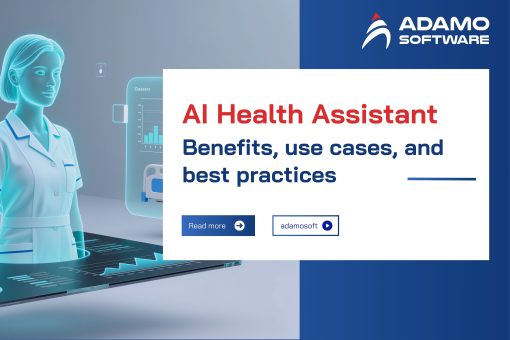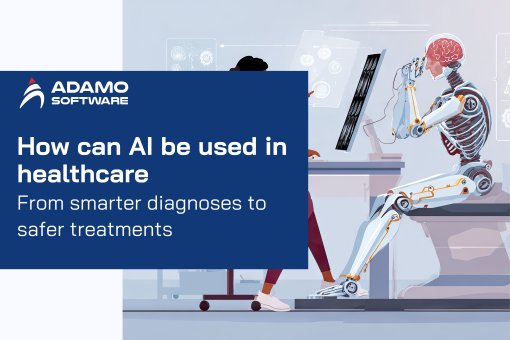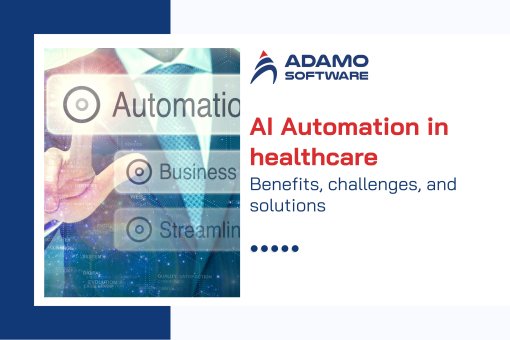What is patient record management system: A full guide for starters
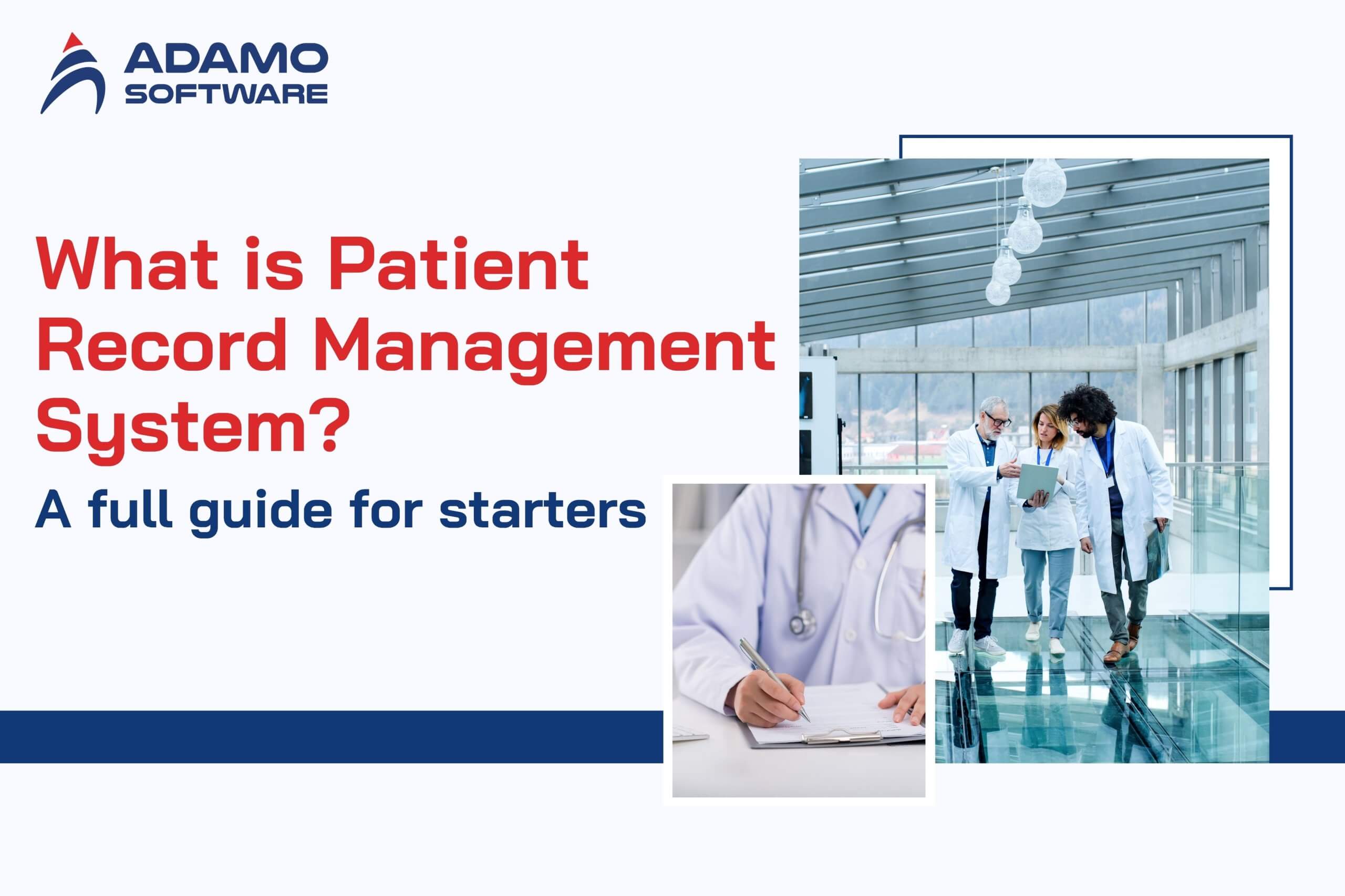
Managing and organizing patient records or data is challenging in the healthcare industry. In the past, patient data was manually entered and stored in the records room for processing medical records. Imagine a clinic or hospital without an efficient system to store and retrieve patient information; it would be chaos! This is where patient record management systems (electronic medical records or management software) come into play, playing a vital role in the healthcare industry.
Patient record management systems ensure that healthcare providers have accurate and up-to-date information about medical activities at their fingertips. They are ultimately improving patient safety, reducing errors, and improving the overall quality of healthcare.
In this article, let’s learn what is patient information management and how it transforms how healthcare providers deliver services and manage patient records.
I. What is patient record management system?
What is patient record management system? A patient information management system, or medical record management system, is software designed to help healthcare providers manage and store patient data efficiently. These systems often come with features like maintaining patient records, scheduling appointments, managing prescriptions, and handling administrative tasks. Healthcare facilities can simplify their workflows, boost operational efficiency, and deliver better patient care using a patient record management system.
II. Main roles of Patient Records Management System in healthcare services
Patient record management systems play a vital role in hospitals and other large healthcare organizations. Let us discuss them:

1. Efficient Data Storage
Patient record management systems ensure efficient data storage. It replaces cumbersome paper records with digital records to store patient information easily and securely. Thus, it saves storage space and minimizes the risk of data loss or damage. In addition, the system also streamlines patient data retrieval, making it easy for healthcare providers to access when needed.
Simply put, doctors and nurses do not have to sift through stacks of paper records thanks to Patient Record Management Systems. At the same time, patient data is kept safe and organized on computers through an electronic patient management system. It makes healthcare more efficient and reduces the possibility of misplacing and losing important information.
2. Enhanced Patient Care
Understanding what is patient record management system can help you improve patient care. It can also improve the accuracy and accessibility of patient information and health history. Healthcare providers can access a patient’s medical billing history, medications, and test results using electronic health records software. This helps them make better and more accurate decisions about diagnosis and treatment.
Simply put, doctors and nurses will have all the information they need at their fingertips with the help of patient monitoring and remote access companies, allowing them to provide the best possible care to their patients.
3. Simplified Workflows
A patient record management system streamlines administrative and clinical processes in healthcare facilities and hospitals. Knowing what is patient record management system makes it easier for healthcare professionals to access, update, and manage patient records. This simplification eliminates the cumbersome paper-based medical record management process and reduces the risk of errors associated with manual record keeping.
Furthermore, the system reduces the administrative burden on staff with features such as appointment scheduling, patient portals, billing, and insurance processing. Simplifying workflows allows healthcare providers to spend more time with patients and improve the quality of care.
4. Improved Communication
Patient record management systems are an important source of information for healthcare professionals and physicians. Understanding what is patient record management systems facilitates improved communication between departments, physicians, nurses, and caregivers. In addition, these Patient record management systems ensure that everyone involved in patient care has access to the same up-to-date information. This prevents miscommunication, duplication, and potential errors in treatment.
In emergencies, these systems provide quick access to critical patient information for timely decision-making and intervention. They also support secure messaging and notifications, enhancing communication between healthcare providers.
Improving effective communication between healthcare professionals is important for patient safety and the overall patient experience. Patients benefit from a coordinated approach to care, leading to better outcomes and satisfaction.
5. Patient Empowerment
Patient empowerment means giving individuals control and access to their health information. Patient record management systems play an important role in enhancing patient engagement. In addition, they allow patients to view their electronic medical records, test results, and treatment plans online.
Giving patients access encourages them to participate actively in healthcare decisions, fostering a sense of ownership and responsibility for their health.
Additionally, patients can schedule appointments, receive test results, and request prescription renewals. Communicating with healthcare providers through these systems makes healthcare more patient-centered. Additionally, patients are more likely to follow treatment plans, ask questions, and engage in shared decision-making with their doctors, leading to better health outcomes.
6. Data Security
Data protection and security are important for every industry, and healthcare is no exception. Patient empowerment means playing an important role in protecting sensitive information security measures. The system uses end-to-end encryption and access control measures. This protects EHR and EMR electronic health record systems from hackers, data breaches, or cyber-attacks.
In addition, patient data needs to be secured and must comply with strict privacy regulations such as HIPAA. Understanding what Patient empowerment means can ensure that electronic patient records are not only easily accessible to authorized healthcare professionals but also highly secure. In addition, regular audits and monitoring are conducted to identify and address security vulnerabilities.
In this way, the patient record management system will gain the patient’s trust and maintain the integrity and confidentiality of the patient’s medical records.
7. Cost Reduction
A Patient record management system plays a crucial role in lowering healthcare expenses. By digitizing and centralizing patient records, it removes the dependency on paper-based documentation. This not only reduces the need for physical storage but also minimizes manual data entry.
As a result, healthcare facilities can achieve significant cost savings by cutting down on paper usage, printing costs, and administrative labor. PRMS streamlines processes, making operations more efficient and budget friendly. Additionally, it helps minimize errors and duplication, lowering the chances of expensive medical mishaps.
8. Research and Analytics
Patient record management systems also contribute to healthcare advancements by leveraging advanced AI, ML, etc. for research and analytics tools. These tools enable us to collect and store large patient data through cloud-based formulas. This data helps researchers identify trends and patterns in diseases, treatment outcomes, clinical decision support, and patient demographics.
In addition, it can also support medical operations, disease management, and the development of new drugs and therapies by providing a comprehensive dataset for analysis and testing. This data is valuable for medical research. It helps healthcare professionals make informed decisions and improve patient care by tailoring treatments to specific groups.
9. Compliance and Reporting
A patient record management system plays a vital role in ensuring that healthcare facilities adhere to legal and ethical standards. Understanding what is patient record management system ensures that patient information is protected. This is done by storing records securely and restricting access to authorized personnel, thereby protecting patient privacy. Compliance with regulations, such as HIPAA in the United States, is important, and a patient record management system facilitates the accurate recording and management of patient data.
This makes it easy for healthcare providers to report and demonstrate compliance with these rules. A patient record management system also streamlines auditing and reporting processes, helping hospitals meet regulatory requirements and avoid legal complications. The system is a guardian, ensuring hospitals comply with regulations and maintain patient trust.
10. Disaster Recovery
Disasters are unpredictable and can strike at any time, making it important for hospitals to be prepared for emergencies. A patient record management system acts as a digital safety net by storing patient records electronically, reducing the risk of losing critical information due to natural disasters or accidents. For example, if a flood damages physical files, electronic records remain intact and accessible.
This is critical to ensuring continuity of patient care. Acting as a digital fortress, a patient record management system protects critical patient data and allows healthcare providers to continue their clinical workflow even when faced with unexpected challenges and patient demographics.
In addition, it can also support medical operations, disease management, and the development of new drugs and therapies by providing a comprehensive dataset for analysis and testing. This data is valuable for medical research. It helps healthcare professionals make informed decisions and improve patient care by tailoring treatments to specific groups.
You can explore more about Hospital Management Systems: Types, Key Features & Must-Know Insights here.
III. Essential Features of Patient Record Management Systems
The goal of patient information management systems is to improve the operations of healthcare providers, making it easier for doctors and medical professionals to work and manage patients. Therefore, these software systems often have several key features that serve the work of doctors and medical professionals, including:

1. Patient examination information management system
Store and organize patient-related data, such as medical history and contact information, to help doctors and medical staff ensure quality patient care.
2. Doctor appointment booking application
Allow patients to book appointments online, support doctors in arranging more optimal schedules, facilitate appointment booking, and improve patient experience.
3. Prescription Management
Doctors can create digital prescriptions, and pharmacists can easily access them, making prescribing and verifying medications simpler.
4. Diagnosis and Clinical Assessment Support
Act as a virtual assistant by providing doctors with important patient information, suggesting potential diagnoses, recommending treatments, and alerting them to possible complications.
5. Test Scheduling
Doctors and healthcare professionals can send test requests for any patient to laboratories and diagnostic facilities and receive results electronically, reducing paperwork costs, and ensuring accurate follow-up.
6. Telemedicine Applications
Enable online connection between doctors and patients via online calls, chats, or messaging, allowing patients to receive consultations without visiting a clinic.
7. Inventory Management
Manage supplies, medicines, and medical equipment to prevent shortages or waste.
8. Patient Portal
Provide patients with easy access to their medical information and electronic medical records, allowing them to check test results, view appointments, and communicate with their doctors.
9. Reporting and Analysis
Collect information from patient records to help doctors improve and enhance treatment, ensure patient safety, and make timely and informed treatment decisions.
IV. Tips to a successful Patient Record Management System
Managing and maintaining patient records has always been challenging and has its challenges. Here are some important points to keep in mind to ensure the success of a patient information management system:
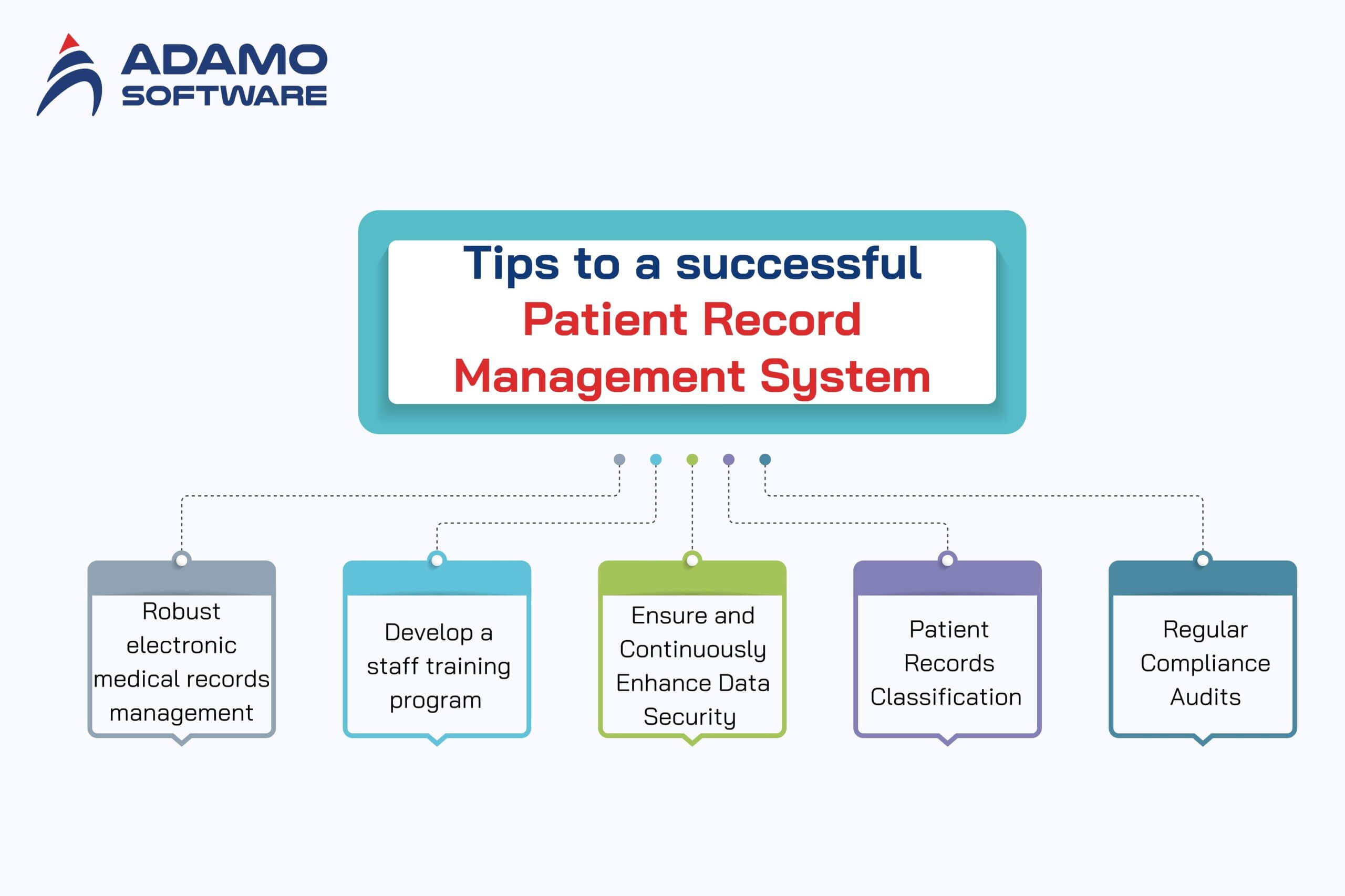
1. Establish a robust electronic medical records management process
This process involves the entire organization, so managers must solicit input from all departments. Additionally, healthcare organizations need to understand data security policies and procedures for patient information management systems, such as HIPAA. Any organizational changes can affect the handling or security of patient health information, so this information must be updated promptly.
2. Develop a staff training program
Healthcare workers or providers may handle sensitive patient health information with proper training. All staff should be trained to interact with the hospital’s patient records management system. This is also a requirement outlined in the HIPAA guidelines.
3. Patient Records Classification
Detailed patient records classification helps healthcare providers track the effectiveness of patient records. Additionally, it facilitates easier retrieval of records when needed or in an emergency.
4. Ensure and Continuously Enhance Data Security
To maintain the reliability of the patient information management system, it’s essential to safeguard patient records throughout their entire lifecycle—from creation to disposal. Electronic records should include an audit trail, while physical records must be stored in securely locked rooms with restricted access. For off-site storage, records must be kept in certified, controlled facilities. When no longer needed, they should be securely destroyed using NAID-certified methods to ensure data protection.
5. Regular Compliance Audits
HIPAA conducts regular and thorough audits to ensure healthcare organizations comply with patient privacy regulations. Organizations should self-assess and monitor their compliance with these regulations to avoid penalties.
V. How can Adamo Software help in Patient Record Management Software development?
Adamo Software is one of the leading software companies in Vietnam. We specialize in developing custom-built patient record management systems (PRMS) that help healthcare organizations automate processes, improve operational efficiency, and ensure secure patient data management. With a deep understanding of the healthcare industry and Industry 4.0 technologies, we create solutions that comply with regulations such as HIPAA, ensuring data privacy and security. Our systems allow healthcare providers to focus on patient care while optimizing internal workflows.

In addition, with extensive experience in IT outsourcing for the digital health solutions industry, Adamo provides scalable and cost-effective solutions. We prioritize sustainability and security, ensuring uninterrupted access to patient information and providing peace of mind with absolute data protection. Contact us for specialized services related to healthcare development solutions.







